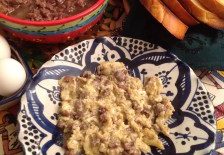Fatteh Hummus: The Resourceful Yet Rich Casserole of the Middle East
By: Blanche Shaheen / Arab America Contributing Writer
If there are people that can turn day-old bread into a sumptuous feast, it would be the people of the Middle East. Resourcefulness is practically in their genes, as they turn lowly lentils into regal Mujaddarah, chickpeas into silky hummus, or stale bread into Fatteh. The word Fatteh in Arabic means “crushed” or “crumbs”, as fatteh transforms dry bread or crumbs into a foundation for rich-tasting casseroles. In this case, day-old pita bread is cut up crouton-sized, then toasted, grilled, or fried. This layer of crunchy bread is then covered with other ingredients that vary according to the region, from Egypt to the Levant.
In Egypt, fatteh is prepared to celebrate the birth of a child, or for holidays like Ramadan. Egyptians add the crispy bread to garlic and vinegar flavored meat soup served alongside rice and a garlic tomato sauce. In Lebanon, Palestine, and Syria, fatteh is served as a breakfast or light dinner. In these countries, the bread is covered with strained yogurt, steamed chickpeas, hummus, fruity extra virgin olive oil, and toasted pine nuts. Sometimes the casserole is topped with lamb cubes braised in clarified butter for an extra hearty dish. Other times home cooks add roasted eggplant instead of the lamb. This casserole-style version is the one I grew up eating with my family, and I was always excited when my mother served this dish any time of day.
Recipe for Fatteh Hummus
One can compare fatteh to a Mexican style 5 layer dip, where pita, yogurt, and chickpeas take the place of refried beans, sour cream, and tortilla chips for dipping. The varying tastes and textures of fatteh all play a symphony on the palate, with buttery chickpeas, cool and creamy minted yogurt, garlicky hummus, and crunchy and nutty toasted pine nuts and croutons. If using dried chickpeas, make sure you soak them in water and baking soda overnight first. This is key for making them easier to digest. If using canned chickpeas you can skip this step. Making your own hummus greatly enhances this dish, but if you are short on time you can use your favorite store-bought hummus. Although this dish is mostly plant-based, you can use a non-dairy unflavored yogurt for a vegan alternative.
To see a demonstration on how to make this dish, you can check out the video below:
Check out Arab America’s blog here!









